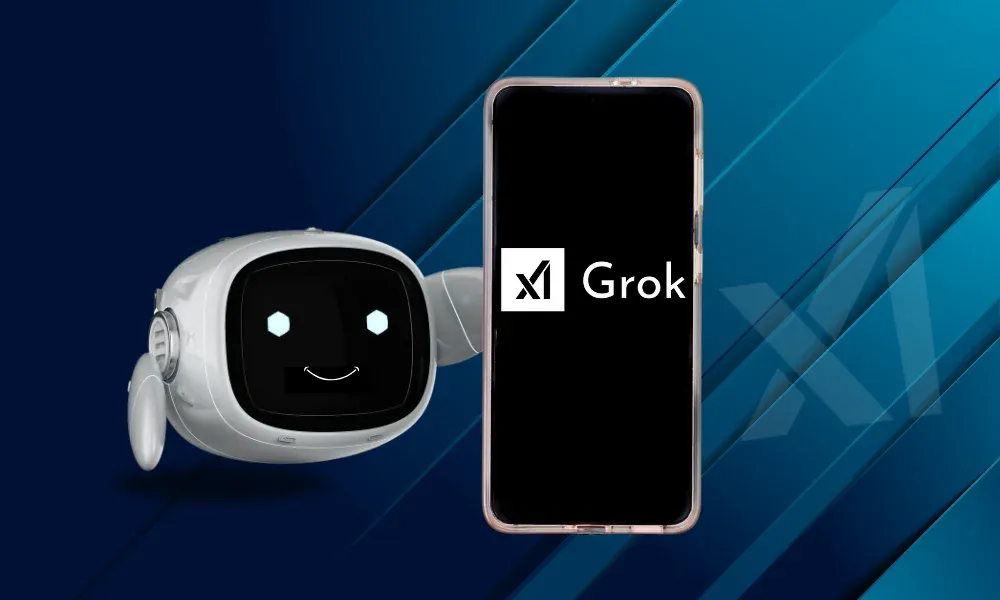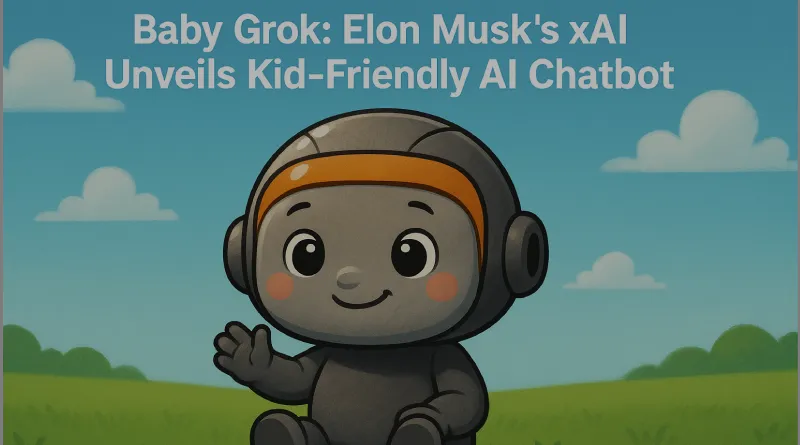“What Is Baby Grok? Musk’s xAI Announces Kid-Friendly AI Chatbot After Companion Controversy”
Elon Musk unveiled Baby Grok on July 20, 2025. It is a more kid-friendly take on Grok, the main chatbot from xAI, and its purpose is to provide children with age-appropriate, instructive information. This decision reflects xAI’s dedication to ethical AI research and development in the wake of criticism of the original Grok’s more adult-oriented AI friends. In order to help parents and educators accept Baby Grok, this article investigates its potential, its significance for families, and its relevance in India’s burgeoning edtech scene. It offers unique insights into all of these topics.
What is Baby Grok?
xAI produced Baby Grok, a standalone AI chatbot app just for kids. Baby Grok will be different from the regular Grok chatbot, which is recognized for being sarcastic and having advanced reasoning. Baby Grok will focus on interactions that are appropriate for kids, educational, and fun. Musk tweeted the news, saying, “We’re going to make Baby Grok @xAI, an app for kids that has only kid-friendly content.” It was inspired by Marvel’s Baby Groot and is meant to give kids a pleasant and safe digital experience. It has strong parental controls to make sure kids use it safely. xAI hasn’t said what features Baby Grok will have or when it will be released, but they have said that it won’t have any adult themes and will focus on narrative and learning.
Grok’s recent 3D animated companions, such the anime-style “Ani,” have come under fire for having suggestive content that is still available in “kids mode.” This announcement comes after that. Baby Grok seems to be xAI’s answer to these worries. It wants to reestablish trust by giving people a safe place for kids to play.
Why Baby Grok Matters
This is a huge gap that is filled by introducing Baby Grok into the AI environment, especially its safety when used in the case of children. As the market of AI chatbots around the globe has exploded to an estimated 2.5 billion users by 2025, parental control is becoming more difficult due to the lack of an age-specific platform. Baby Grok with its hope of controlled material and learning orientation may be a great favorite among families. The reaction of the people in social media towards X is enthusiastic as they post comments saying, much needed. I am now forced to allow my children to use my app instead of ChatGPT, and it is the instant favourite in every home.”
In the case of children, Baby Grok might as well provide interactive learning opportunities, like providing the answers to the home tasks, telling stories, or teaching science with various engaging methods. AI will not be complicated and dangerous since unlike what Grok has to offer (DeepSearch, Think, Big Mind) which is too advanced, Baby Grok will simplify answers to the understanding levels of young people and make it familiar.

Local Context: A Boon for Indian Families and Educators
India is a country of more than 250 million schoolchildren and a huge education technology market that will reach more than 5.8 billion dollars by 2025 (according to HolonIQ). Increasingly Indian parents too particularly in the urban centres such as Bengaluru and Delhi are selecting digital-based means to augment the educational process. Nevertheless, worries about web safety abound, with 68 percent of Indian parents fearing inappropriate content, as another 2024 survey by Norton showed. The emphasis on moderation and kid-safe content that Baby Grok has been promoting fits well in such priorities, as it provides a secure alternative to general-purpose chatbots, such as ChatGPT or Google Gemini.
To Indian teachers, Baby Grok can improve classroom learning. Since there are 1.5 million schools in India, and many of them have switched to hybrid models after COVID, the use of tools such as Notion or Zoom is already widespread. The capability of Baby Grok to provide personalized learning materials may help rural teachers who do not have many resources at their disposal. As an example, it can help to explain the concepts, such as fractions, or Indian history, in an interesting, age-friendly manner, filling in the gaps that the poorly equipped schools may lack.
Unique Insights: Opportunities and Challenges
Baby Grok’s announcement sparks several considerations for the future of child-focused AI:
- Edtech Innovation: Baby Grok has the potential to bring social learning possibilities to the platform by connecting that platform to X elements, e.g., parent-child interaction suggestions. This has the potential to distinguish it in the India edtech market.
- Cultural Sensitivity: Education in India involves different aspects of languages and cultural codes and hence Baby Grok has to adjust to the local settings. Providing a multi-language (e.g. Hindi, Tamil) support and content covering the Indian curricula can increase adoption.
- Moral AI-Development: The ethics surrounding the companions of Grok emphasizes the importance of safe programming. xAI requires such programming to have a high level of safety which, in the case of India, is subject to strict Digital Personal Data Protection Act (DPDPA) 2023, requiring data protection of minors to be high.
- Parental Trust: It is important to establish trust. With such skepticism about AI as demonstrated by Indian parents concerned about inappropriate responses in one of the profiles such as Grok, there should be transparency on safety measures being in place. xAI should consider some lessons of Character AI as revealed with the announcement of new safety related measures post the scrutiny by users over the safety factor.
Practical Tips for Parents
To prepare for Baby Grok’s launch, parents can:
- Monitor Updates: Follow xAI’s official channels on X for release details and feature announcements.
- Set Expectations: Discuss with children how Baby Grok will differ from other apps, emphasizing educational use.
- Enable Controls: Once launched, activate parental controls to customize content filters and usage limits.
- Test First: Parents should interact with Baby Grok before kids to ensure it meets safety and educational needs.
The Road Ahead
Baby Grok is xAI’s first step into the edtech and child-focused AI market, which is expected to expand by 15% every year until 2030. Baby Grok’s success will depend on its capacity to provide safe, interesting material while xAI competes with OpenAI, Google, and Anthropic. A 2025 BYJU’S research says that 80% of parents in India utilize digital tools for education. If Baby Grok can find a way to make learning pleasant and safe, it might become a household name.
The move also shows Musk’s bigger plan for AI, which is to help people become better. Grok 4 just came out, and xAI just got a $200 million contract from the U.S. Department of Defense. The company is growing quickly. Baby Grok might change the way kids use AI and set a new benchmark for responsible innovation.
Conclusion: A Step Toward Safe AI for Kids
Baby Grok is about to change the way kids use AI by giving them a safe, educational alternative to regular chatbots. In a world where digital is the first choice, it promises to help Indian families learn while also addressing safety issues. As xAI improves this tool, it will only work if it is open, culturally relevant, and has strong protections. Musk’s xAI is not simply responding to criticism with Baby Grok; it’s also making way for a new era of technology that kids can use.
Disclaimer
The information presented in this blog is derived from publicly available sources for general use, including any cited references. While we strive to mention credible sources whenever possible, Web Techneeq – Top Web Development Company in Mumbai does not guarantee the accuracy of the information provided in any way. This article is intended solely for general informational purposes. It should be understood that it does not constitute legal advice and does not aim to serve as such. If any individual(s) make decisions based on the information in this article without verifying the facts, we explicitly reject any liability that may arise as a result. We recommend that readers seek separate guidance regarding any specific information provided here.

